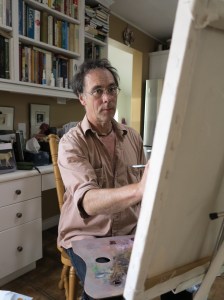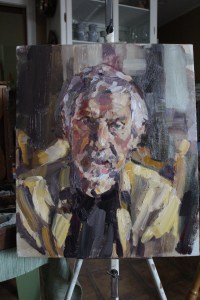
Stephen Paints a Picture: Part Eleven
October 30, 201319 August 2012
 “Did you check out Stuckism on the web last night?” I asked Stephen Scott as soon as he stepped into the house.
“Did you check out Stuckism on the web last night?” I asked Stephen Scott as soon as he stepped into the house.
“Sure did. Strange stuff, but when you boil it down, I guess we are both Stuckists,” he said.
I had told him to take a look at the movement the night before because I thought he would find it interesting after all our talk about the Young British Artists movement. The term Stuckism comes from a remark made by Tracey Emin, a member of the Young British Artists, to her then boyfriend, Billy Childish, about the art that he was doing, in her words, was so “stuck, stuck, stuck” in the past. The relationship failed, but the term lived on as Stuckism complete with a manifesto and followers all over the world as an anti-anti-art movement. The artists in the movement wanted a return to figurative art and away from the conceptual art that seemed to be in control of British art at the time (1998/99). They went so far as to picket the Turner Prize every time it was awarded.
“I thought that you would find it funny. Too bad that most of the Stuckists painters I could find suck, but their hearts are in the right place,” I said.
“Yes, and interestingly enough, I couldn’t find any Canadian artists on the list of members,” he said.
“Perhaps, it’s time for us to form a Canadian chapter,” I said.
“Well let’s get started,” Stephen said, trying to get everything in place for painting while trying to avoid my dogs who always want to be in the centre of things. “I think you know my thoughts on chaos and art.” I said as I assumed my pose for his painting, “ Did I ever talk to you about Morse Peckham’s book, Man’s Rage for Chaos? I think you would find it an interesting read.” “No, I don’t think that you did.” Stephen pointed his brush at me and used it to direct my head at the angle he wanted.
“Well, Peckham maintains, and I agree, that art, or at least progress in art, is not about order, but the reverse and that art moves ahead through disorder and chaos.”
“That very well might be true, but there is a case to be made for order within a work of art.”
“I was thinking more of changes in the direction of the history of art like where in hell did Cubism or Dada come from.”
“Surely, actual history rather than art history had something to do with it. World War I and psychoanalysis really fucked things up,” he said.
“Of course, they did, but I think you can see chaos in art throughout history. It’s not that I don’t like order, only that I have a hard time with progress.”
 “I think that there is a lot of chaos in this damn picture,” he said, “it’s fighting me all the way.” I asked him what he meant by fight. “At the moment the colour is rather dull. It should sing.” “Like the fat lady?” I said. “Sometimes working with a limited palette is a bit of a challenge, but I like the natural colours I use,” he said. “The singing bit is all about local colour (the contrast between one colour with another) isn’t it? I asked. “Sure, that’s why the background in a portrait is important. A dark background will make the colours in the face pop out.” He was working on the left side of face which was the darker side as I was lit from the right. “The paint is what it is all about. You are just an excuse to paint,” he said. “I hope you don’t say that to all your sitters especially those who are paying you,” I said, but I knew where he was coming from. The act of painting is rather like being a child in a sandbox; it’s all very tactile.
“I think that there is a lot of chaos in this damn picture,” he said, “it’s fighting me all the way.” I asked him what he meant by fight. “At the moment the colour is rather dull. It should sing.” “Like the fat lady?” I said. “Sometimes working with a limited palette is a bit of a challenge, but I like the natural colours I use,” he said. “The singing bit is all about local colour (the contrast between one colour with another) isn’t it? I asked. “Sure, that’s why the background in a portrait is important. A dark background will make the colours in the face pop out.” He was working on the left side of face which was the darker side as I was lit from the right. “The paint is what it is all about. You are just an excuse to paint,” he said. “I hope you don’t say that to all your sitters especially those who are paying you,” I said, but I knew where he was coming from. The act of painting is rather like being a child in a sandbox; it’s all very tactile.
“How do you know when to move from a study to a finished work or even when a study is finished?” I said. “It just looks right. Some elements have come together and you know it’s time to move on.” I made us both a cup of coffee and took at a look at what he was doing. “Are you going to go back to the first painting and try to finish it,” I said. “Likely, but I might move to another oil sketch instead. There is never enough time for anything.” “What is it that you are looking for in this painting that wasn’t in the last one?” I asked Stephen. “Don’t really know, perhaps it has something to do with composition or focus,” he said. “Every mark means something and every mark in every picture is different,” I said. “You can’t really think about it. I just have to force myself to work every day. If I thought about it too much, I would end up stopping,” he said.
Stephen’s advice was wise, as I do tend to think too much which inevitably gets me in trouble. “I guess you’re right, if I stuck more to my brush and less about getting everything right, I would still be painting,” I said. “No, I still want to get things right, but if you just keep doing it somethings are bound to come out right,” he said.
“I sometimes feel that I’m walking on the edge of a razor blade with death on one side and life on the other towards an inevitable oblivion,” I said.
“Now that’s morbid.”
“No, I’m just pissed off that I have wasted away my life and you, on the other hand, at least have a body of work.”
“What do you mean? Your taught all your life. Tons of students and then there is all your writing,” he said
 “I’m not sure to what end and, in the last fifteen years of my life, I’ve been a small-town politician. It’s only now that I am trying to re-invent myself and I don’t have another fifteen years. Shit, I’ll be ninety. Most people at ninety are dead.”
“I’m not sure to what end and, in the last fifteen years of my life, I’ve been a small-town politician. It’s only now that I am trying to re-invent myself and I don’t have another fifteen years. Shit, I’ll be ninety. Most people at ninety are dead.”
“You should really stop feeling sorry for yourself, get off your ass and just write,” he said.
We were now back painting.
“You know,” he said, “painting is a healthy way to express unhealthy feelings.”
“Yes, Lucian Freud certainly had that down to a science,” I said. “You can say almost anything in painting and get away with it,” he said.
We were back on a favourite subject. What art allows us to say that cannot be done by other means; the so-called artistic licence.
“Art is a therapeutic tool tool, an emotional experience and the tool is in the making,” he said.
“I thought you said that this was fun?” I said.
“It is, but it’s lots of things, all at the same time.”
“Isn’t the process more important than the product for you?” I said.
“Certainly, definitely.”
“Well most viewers could care less about process. They are generally looking for a pretty picture or some kind of experience that comes from contact with a finished art work,” I said.
“There is the big difference between the maker and the viewer,” he said.
“Mind you, the viewer can make up their mind about a painting in a second while the artist can take weeks to finish the same painting. Hardly fair is it?” I said.
“The term ‘finished’ is a problem and perhaps we should bring today’s session to a finish. I could use a drink,” he said, getting in the last word.
© Virgil Hammock, Sackville NB Canada, Monday, October 28, 2013.
Evidently J. M. Turner had a ‘finished’ problem. They found him on a step ladder in the Tate in his dotage, repainting some bit that had pissed him off.
Nothing is ever finished except by death.